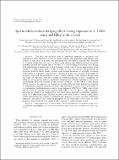Files in this item
Sperm whales reduce foraging effort during exposure to 1-2 kH z sonar and killer whale sounds
Item metadata
| dc.contributor.author | Isojunno, Saana | |
| dc.contributor.author | Curé, Charlotte | |
| dc.contributor.author | Kvadsheim, Petter Helgevold | |
| dc.contributor.author | Lam, Frans-Peter Alexander | |
| dc.contributor.author | Tyack, Peter Lloyd | |
| dc.contributor.author | Wensveen, Paul Jacobus | |
| dc.contributor.author | Miller, Patrick James O'Malley | |
| dc.date.accessioned | 2016-03-22T16:30:03Z | |
| dc.date.available | 2016-03-22T16:30:03Z | |
| dc.date.issued | 2016-02-08 | |
| dc.identifier | 241576605 | |
| dc.identifier | cfedeefb-45a0-476a-8fbc-47d037e39720 | |
| dc.identifier | 84959470327 | |
| dc.identifier | 27039511 | |
| dc.identifier | 84959470327 | |
| dc.identifier | 000369511000008 | |
| dc.identifier.citation | Isojunno , S , Curé , C , Kvadsheim , P H , Lam , F-P A , Tyack , P L , Wensveen , P J & Miller , P J OM 2016 , ' Sperm whales reduce foraging effort during exposure to 1-2 kH z sonar and killer whale sounds ' , Ecological Applications , vol. 26 , no. 1 , pp. 77-93 . https://doi.org/10.1890/15-0040 | en |
| dc.identifier.issn | 1051-0761 | |
| dc.identifier.other | ORCID: /0000-0002-2212-2135/work/37031849 | |
| dc.identifier.other | ORCID: /0000-0002-8409-4790/work/60887908 | |
| dc.identifier.uri | https://hdl.handle.net/10023/8462 | |
| dc.description | We would like to thank 3S partners and funders especially for enabling this research (NL Ministry of Defence, NOR Ministry of Defence, US Office of Naval Research, and World Wildlife Fund, Norway). PLT was supported by the Scottish Funding Council (grant HR09011) through the Marine Alliance for Science and Technology for Scotland. | en |
| dc.description.abstract | The time and energetic costs of behavioral responses to incidental and experimental sonar exposures, as well as control stimuli, were quantified using hidden state analysis of time series of acoustic and movement data recorded by tags (DTAG) attached to 12 sperm whales (Physeter macrocephalus) using suction cups. Behavioral state transition modeling showed that tagged whales switched to a non-foraging, non-resting state during both experimental transmissions of low-frequency active sonar from an approaching vessel (LFAS; 1-2 kH z, source level 214 dB re 1 μPa m, four tag records) and playbacks of potential predator (killer whale, Orcinus orca) sounds broadcast at naturally occurring sound levels as a positive control from a drifting boat (five tag records). Time spent in foraging states and the probability of prey capture attempts were reduced during these two types of exposures with little change in overall locomotion activity, suggesting an effect on energy intake with no immediate compensation. Whales switched to the active non-foraging state over received sound pressure levels of 131-165 dB re 1 μPa during LFAS exposure. In contrast, no changes in foraging behavior were detected in response to experimental negative controls (no-sonar ship approach or noise control playback) or to experimental medium-frequency active sonar exposures (MFAS; 6-7 kH z, source level 199 re 1 μPa m, received sound pressure level [SPL] = 73-158 dB re 1 μPa). Similarly, there was no reduction in foraging effort for three whales exposed to incidental, unidentified 4.7-5.1 kH z sonar signals received at lower levels (SPL = 89-133 dB re 1 μPa). These results demonstrate that similar to predation risk, exposure to sonar can affect functional behaviors, and indicate that increased perception of risk with higher source level or lower frequency may modulate how sperm whales respond to anthropogenic sound. | |
| dc.format.extent | 17 | |
| dc.format.extent | 489300 | |
| dc.language.iso | eng | |
| dc.relation.ispartof | Ecological Applications | en |
| dc.subject | Anthropogenic noise | en |
| dc.subject | Behavioral budget | en |
| dc.subject | DTAG | en |
| dc.subject | Functional state | en |
| dc.subject | Naval sonar | en |
| dc.subject | Northern Norway | en |
| dc.subject | Physeter macrocephalus | en |
| dc.subject | Risk-disturbance hypothesis | en |
| dc.subject | Sperm whale | en |
| dc.subject | State-switching model | en |
| dc.subject | Time series model | en |
| dc.subject | QH301 Biology | en |
| dc.subject | Ecology | en |
| dc.subject | BDC | en |
| dc.subject | R2C | en |
| dc.subject.lcc | QH301 | en |
| dc.title | Sperm whales reduce foraging effort during exposure to 1-2 kH z sonar and killer whale sounds | en |
| dc.type | Journal article | en |
| dc.contributor.institution | University of St Andrews. School of Biology | en |
| dc.contributor.institution | University of St Andrews. Sea Mammal Research Unit | en |
| dc.contributor.institution | University of St Andrews. Centre for Social Learning & Cognitive Evolution | en |
| dc.contributor.institution | University of St Andrews. Marine Alliance for Science & Technology Scotland | en |
| dc.contributor.institution | University of St Andrews. Sound Tags Group | en |
| dc.contributor.institution | University of St Andrews. Bioacoustics group | en |
| dc.contributor.institution | University of St Andrews. Scottish Oceans Institute | en |
| dc.contributor.institution | University of St Andrews. Institute of Behavioural and Neural Sciences | en |
| dc.contributor.institution | University of St Andrews. Centre for Research into Ecological & Environmental Modelling | en |
| dc.identifier.doi | 10.1890/15-0040 | |
| dc.description.status | Peer reviewed | en |
| dc.identifier.url | http://onlinelibrary.wiley.com/doi/10.1890/15-0040/full | en |
This item appears in the following Collection(s)
Items in the St Andrews Research Repository are protected by copyright, with all rights reserved, unless otherwise indicated.

